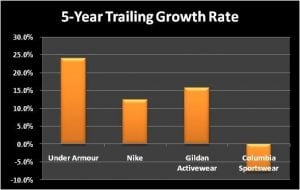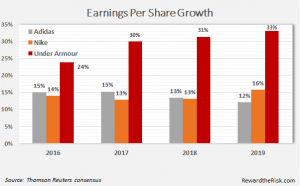A decade back, we all knew about great sports brands like Nike, Adidas, Puma, Umbro, and Lotto to name a few. Nike was a clear leader off late when it came to the market capital.
But when it came to growth, Under Armour is proving to be a threat to Nike’s revenue in recent past

When a relatively new and smaller player (Under Armour) combats against the predominant force in the industry (Nike) the key to success often lies in introducing innovative products and efficient management.
And when we talk about an uprising sports brand, it all boils down this Baltimore-based company, Under Armour. Innovative products are the reason behind its constant growth to position itself against the industry giants like Nike.
We are witnessing some fierce competition between Nike and Under Armour since the beginning of 2016. The results clearly reflects how Under Armour is surpassing the expectations to show that it just needs few strategic moves to get hold of Nike.
Going by the words of Brad Dickerson (UA’s ex-chief financial officer), UA is anticipating a higher share of growth over the next few quarters. Reason being company’s endeavor to deliver the consumer products pretty fast on a season-to-season basis. UA is constantly manufacturing their goods almost four times each year, and as mentioned by Henry Stafford, UA’s chief merchandising officer, it has doubled its previous amount. It has led UA to speed up their market proliferation in 2016. These figures directly imply targeted and more recurrent product assemblages.
There are certain points of comparison where we can gauge the efficiencies and inadequacies of the leading sports brand giants, Nike and Under Armour.
Product Assortment
UA’s growth heavily relies on its of product assortment. It includes variety by both, channel and geography. This assortment is principally germane as UA seeks advanced proliferation into the international operations by further expanding its supply chain maneuvers in North American retail (XRT) stores as well as the online disposition.
As long as Nike’s product assortment is concerned, it expects unprecedented growth in North America with the main focus being Women’s Training in Factory Stores and by drawing a parallel to undermine how this can progress overall Nike’s Brand inventory.
Supply chain enhancements
Under Armour’s core focus lies in shrinking its supply chain by cutting down the lead times for various operational activities like procuring raw materials, and augmenting manufacturing process. Also, the crucial element is to set dates for goods and ensure that it reaches within the predefined time. UA is also discovering ways to ship products directly to the customers from its source.
The thing about Nike’s inventory is that it is the Nike’s most valuable asset. Nike’s balance sheet reflects the inventory of $3.9 Billion (as of May 31st, 2014). These figures clearly indicate Nike’s supply chain wealth. Though being an asset, Nike being a global leader keeps on exploring new markets, innovating new products and proliferating its supply channels. Such constant initiatives require a dynamism in its SCM. In the process of broadening sales portfolio, Nike is experiencing certain complexities in managing its supply chain operations. But reportedly, Nike reacted to address this complexity by rupturing its supply chain into smaller subdivisions, Couture each of their divisions targeting particular market and consumer wants. Nike’s corporate investment portfolio evidently reflects its belief in refining their supply chain competencies, sub-structuring the same with constant, research and recruiting.
Engaging SAP for effective SCM
UA has a long collaboration with SAP for providing or ERP solutions. This alliance is aimed towards optimizing inventory, process enhancements, and amending effective cost management. Expecting inventory strategy to work out, the benefit as commented by Paul Fipps will be reflected in 1Q17.
What happened with Nike back in 2000 indicates a problem that surfaces around a typical enterprise solution failures. Nike was using the i2 solution as a demand-planning software. Although, as claimed by Nike, the problems were rather fixable, primarily because they were technical in nature.
Apart from being slow, the ERP-based problem with i2 point towards inefficient deployment and lack of system integration. Also, it came along with few bugs and to add up the vulnerability, Nike’s supply chain executives had not trained adequately for system usability before everything went live. Though Nike claimed to have solved the problems by Fall 2000, and that the business remained stagnant post that quarter.
But the sales strategy contradicts to what Nike representatives had to say. Let us take into consideration how few of the less selling shoes were sent back to factories couple of times. One of which came from the older management system while the other came back post-deployment of a new system. Moreover, newer model orders ‘fell through the cracks’. Consider Foot Locker’s example. Foot Locker is Nike’s largest retailer in the US, and it went on to reduce prices of Air Garnet III from $140 to $90. Likewise, Air Terra Human 2 came with the selling price of $100, and the same was reduced to 50%.
Implications of Inventory Management
If we are to consider UA’s inventory turnover ratio, it is indeed one of the lowest amongst their competitors. The ITR was locked to 3.0x during last year, in 2015. If we are to compare Nike on this grounds, then its ITR is 4.0x, while LuLu keeps it at 4.5x.
Two elements – Swiftness to market and rich assortments drives the demand for footwear and apparel companies. The inventory management initiatives of Under Armour apparently reflects company’s strategic alignment towards utilizing inventory management as a cost-cutting tool which in turn can yield high inventory turnover with an active SCM. In longer run, Under Armour is expected to outperform global giants regarding share growth.

While the war is still on between these two giants, Under Armour’s active SCM is clearly reflecting in their growth story. Nike, on the other hand, is still in the bewilderment about how a new company can take a head-on with a global giant. But it seems, UA’s inventory management team have mastered the art of supply chain growth hack.



